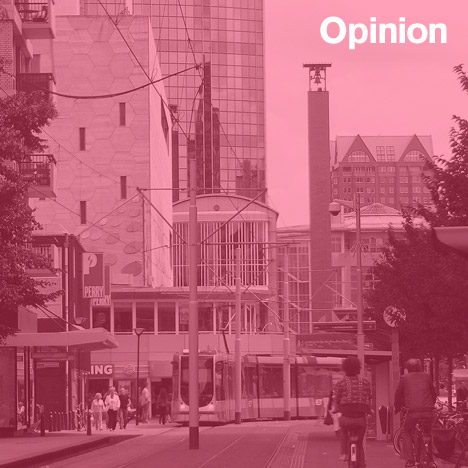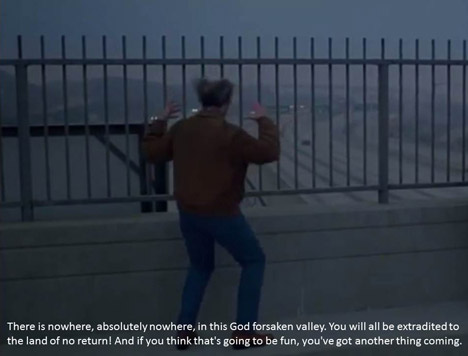
"The vast majority of the built environment is of an unspeakable ugliness"
Opinion: the legacy of the Modernist movement is a "God complex" among contemporary architects that is turning architecture into its own worst enemy, says OMA partner Reinier de Graaf in his first column for Dezeen.
Shortly after I graduated, someone asked me: "Why did you study so intensively for so long? Isn't architecture basically four walls and a roof?" The bluntness of this question took me aback, and 25 years later I still struggle to come up with an answer.
After the 2014 Venice Architecture Biennale, my answer could be: "No, it is four walls, a roof, a window, a stair, perhaps a ramp, an elevator, perhaps an escalator, a balcony and possibly a (long) corridor..." A more elaborate answer, yes, but I doubt if it would have sufficed to dismiss the skepticism that underlay the question.
Throughout my career, I have struggled to justify to others – particularly to those who are not members of my profession – why my job is important and why it should remotely qualify as a source of pride. Even while writing this (on a train on my way to work) I could not help but be overcome by a sense of shame when I paused to look out of the window.
The vast majority of the built environment is of an unspeakable ugliness: an infinite collection of cheaply made buildings engaged in a perpetual contest to see which one can generate most "interest" for the lowest budget. Nothing more, nothing less.
Modern architecture – the kind of architecture most of us claim to admire – hasn't helped. It has largely proved a "facilitator": an extension of the means to conduct this pointless contest only at a more intensified pace. Modern architecture's true legacy is not Modern architecture, but Junkspace.
Never had this been more apparent than in this year's edition of the Venice Biennale. In the central pavilion, deliberately dressed up as a building trade fair, each room was dedicated to an individual element of architecture; together these elements make up the body of architecture. But it is invariably the history of each element that sparks enthusiasm.
The delight is in the discovery of a kind of intelligence that appears to have been there since the beginning of time. Actually, a strange sense of progress emerges the further you go back in time, independent of – and often largely at odds with – technological progression. Here, the future seems mostly a well-forgotten past: a kind of progress in reverse. The great inventors are long dead and mostly not known by name.
Why do we contemporary architects wallow so much in the conviction that we have grand visions to offer? Where does it come from, this "God complex", this desire to view ourselves as an authority, essentially on everything? The world at large seems largely disenchanted. I have yet to meet a client, a public official, or any (group of) user(s) that is truly interested in the larger visions we claim to offer, the motivations we give for our decisions or indeed anything we have to say in general. Let's face it: architects talk for architects. As far as the rest of the world is concerned they can remain forever silent. They should simply get on with their job of designing buildings, which, if they are any good, should speak for themselves.
I often wonder if we would be better off if we were a little more discreet about our profession, almost like an old society of Freemasons. Not the great inventors, or the announcers of every next revolution (in architecture there seems to be one happening almost every week), but the custodians of centuries of secrets.
Campaigns focused on the importance of individual architects mainly seem to serve as a disguise for architecture's failing as a collective – a kind of pre-emptive disclaimer, where our failures are invariably the fault of others. The hype around contemporary architecture, and the myth of the individual genius that comes with it, seems little more than a convenient decoy that allows us to shed any notion of a collective responsibility – a disingenuous crusade against what are ultimately our own sins. But how much longer can we continue to boast the relevance of our profession, before our complicity in that which is being done in its name catches up with us?
There is an ever-larger number of architectural offices with an ever-smaller size, plagued by ever-shorter pipelines. Imagine the ultimate outcome of this trend – a fully atomised situation where eventually the number of practices equals the number of architects, all of them desperately in search of someone willing to give them serious responsibilities.
The larger part of their working day will be consumed by writing mission statements. What better way to fill the time between one project (some time ago) and the next (not any time soon)? The smaller the offices, the smaller the audience for the architect to talk at. In the short term a professional scene of many small offices will lead to a larger number of visionaries, listened to by fewer people. From architects talking for architects, we "evolve" to every architect talking to himself.
There is a scene in the film Paris Texas by Wim Wenders: from a highway overpass, a clearly deranged man delivers prophecies to six lanes of passing traffic below. He screams at the top of his lungs, the contents of his speech are eloquent and melodious, but the drivers below, shielded by their steel harnesses, remain immune to the depth of his words. The man goes unheard, but that hardly seems to discourage him. In fact it only inspires him to raise his voice further.
To what extent does this man resemble the contemporary architect? A person assuming to possess privileged knowledge, to whom everyone around him appears to be deaf. A person who stands motionless, while everything around him is in motion. A person who prophesises from a bridge, looking over the ones below (who he keenly refers to as "the masses"), but also increasingly a needy person, far removed from the wealth with which he was once associated, and – if economic indicators are anything to go by – pretty soon a lone drifter, in search of shelter... of four walls and a roof.

Reinier de Graaf is a partner in the Office for Metropolitan Architecture (OMA) where he directs the work of AMO, the research and design studio established as a counterpart to OMA's architectural practice. The above text was developed from an introductory statement to a workshop of young Dutch architects about the future of the architect in 2024, held during the finissage of the 2014 Venice Architecture Biennale.